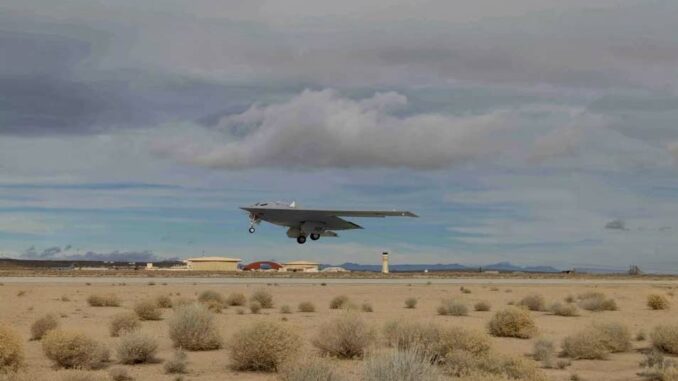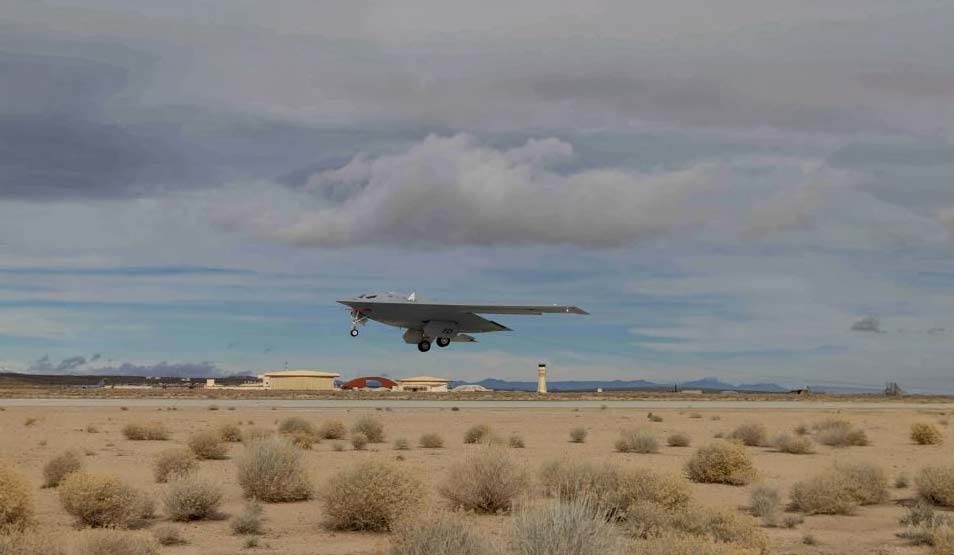
Technical analysis of the USAF B-21 Raider, its capabilities, development and implications for future military aviation.
The development of the B-21 Raider stealth bomber by the US Air Force (USAF) is taking place in almost total secrecy. This article examines the B-21’s advances, its technical capabilities, its production process, and its implications for the future of military aviation.
B-21 Raider: Background and Development
The B-21 Raider is currently undergoing testing and production, with the USAF aiming to introduce this next-generation platform from the mid-2020s. Since its unveiling in December 2022, the B-21 has begun flight testing at Edwards Air Force Base in California, where it continues to progress. Intended to replace the B-1B Lancer and B-2 Spirit, the B-21 is designed to penetrate enemy air defense networks and carry out precise strikes. The USAF plans to produce at least 100 units, all manufactured by Northrop Grumman.
Test and Production Process
The B-21 acquisition program is managed by the USAF Rapid Capabilities Office, which focuses on the manufacture of test aircraft representative of final production. Unlike the traditional flight prototype approach, B-21 test aircraft are built using the same manufacturing processes and tooling as production aircraft, to speed up the build process.
For example, in recent testimony before the Senate Armed Services Committee, Andrew Hunter, Assistant Secretary of the Air Force for Acquisition, Technology and Logistics, emphasized that flight testing of the B-21 was on track to meet schedule. This means that the unique features of this platform are being effectively tested and evaluated, which is essential to ensure that the B-21 meets the USAF’s operational expectations.
B-21 Operational Basics
Once operational, the B-21 will be based at Ellsworth AFB in South Dakota, which will also be the site of the formal training unit. Whiteman AFB in Missouri and Dyess AFB in Texas are the other preferred sites for the B-21 as aircraft become available. This geographic distribution will ensure optimum strategic coverage of the United States, and facilitate crew and aircraft training and maintenance.

Economic analysis and benefits
The unit cost of the B-21, adjusted for inflation, is estimated at around $750 million, a significant reduction on the $2 billion per unit for the 20 older B-2s. Economies of scale and improvements in stealth coatings reducing maintenance requirements have contributed to this cost reduction. However, exact figures are kept under strict confidentiality by the US military.
The B-21’s theoretical capabilities in terms of stealth, sensor networking and optional piloting make it the world’s first sixth-generation aircraft. This advance goes beyond fifth-generation systems such as the American F-35 or the Chinese J-31. The development of the NGAD (Next Generation Air Dominance) platform by the United States, planned to succeed the F-22 Raptor, is also part of this technological dynamic.
Positives of the B-21
Stealth capabilities:
The B-21 is designed to evade enemy detection systems thanks to its advanced stealth technology. This capability enables deep penetration missions without being detected, thus increasing strike effectiveness.
Versatility:
Thanks to its modular architecture, the B-21 can be rapidly adapted for different missions, from conventional strikes to nuclear operations. This flexibility makes it a major strategic asset for the USAF.
Low cost:
The unit cost of $750 million represents a significant reduction compared with previous platforms. This means it can be acquired in larger numbers without exceeding military budgets.
B-21 Negative Points
High development costs
Despite the reduction in unit cost, initial development of the B-21 remains extremely costly. Research and development investments for advanced technologies are substantial, which can weigh on the overall defense budget.
Technological complexity:
The complexity of on-board systems and stealth technologies requires specialized and costly maintenance. This can lead to long-term logistical and financial challenges.
Vulnerability to cyber attacks:
With the integration of advanced network systems, the B-21 could be a target for sophisticated cyberattacks. Ensuring the cybersecurity of these platforms is a major challenge for the USAF.
Potential consequences
Strategic Impact:
The introduction of the B-21 could change the world’s strategic balance, by strengthening the United States’ power projection capability. This could encourage other nations to accelerate their own stealth bomber development programs, thereby increasing the arms race.
Technological development:
The technologies developed for the B-21 could have wider civilian and military applications, contributing to technological advances in a variety of fields, including commercial aviation and cybersecurity.
International alliances:
The B-21 could strengthen U.S. alliances with its partners by providing a credible deterrent against potential threats. However, it could also provoke increased tensions with adversary powers such as China and Russia.
The development of the B-21 Raider represents a significant step forward for the USAF, both technologically and operationally. Its stealth capabilities, versatility and low unit cost make it a major strategic addition. However, the challenges of development costs, technological complexity and cybersecurity must be managed proactively. In the long term, the B-21 could redefine global air defense capabilities and strategic balances.
War Wings Daily is an independant magazine.